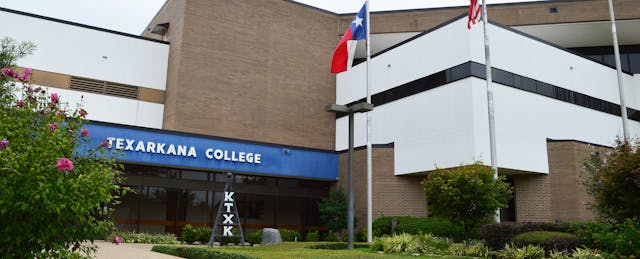This is the first part of a three-part series looking at how one college in Texas staged a turnaround. For more, check out parts two and three.
TEXARKANA, Texas — There’s a saying at the community college here on the border between Texas and Arkansas: “Texarkana College is a great place to start, or start over.”
The tagline speaks to the student body at the institution, many of whom are juggling jobs, parenting and studies with hopes of brighter futures ahead. But it also speaks to the school itself, which less than a decade ago, was on the brink of a total bankruptcy and collapse.
“It was about as big a mess as you can ever imagine,” says James Henry Russell, who left his previous role as superintendent of Texarkana Independent School District to become president of the college in 2011.
Since those days though, Texarkana College has earned a new reputation. Graduation rates for first-time, full-time students more than tripled from 2008 to 2016. And the college has won awards from higher-ed nonprofits that have applauded the school for its turnaround.
Texarkana College adopted new enterprise software and other edtech tools like an early-alert system, but technology was only one aspect of the school’s effort. And in fact, some officials attribute poor technology purchasing decisions as one of the roots of their troubles.
Instead, what got Texarkana College back on track involved a mix of fate and drive: having a famed billionaire alumni, a campaign to increase local funding to the school, and cultural upheaval.

The state line goes directly down the center of downtown Texarkana, dividing the city in two: Texarkana, Texas and Texarkana, Arkansas.
Texarkana College serves both. These days, like many community colleges around the country, the institution struggles to recruit students and stay in vogue. But that wasn’t always the case, according to officials who have seen the school at its best and its worst.
“When I first came here, it was just the best of all times in 1990. We had $40 million in surplus,” says Dean of Students Robert Jones. “It was just like everything was fine and dandy.”
Things changed in 2001, when then-president Carl Nelson died unexpectedly, leaving the campus and its leadership in shock. The college cycled through two other presidents before Russell stepped in seven years ago. By the time he did, it was almost too late.
“I got there and realized that the college was losing about $800,000 a month,” says Russell. “Three years earlier, the college had a reserve of about $17 or $18 million dollars. It had gotten down to $1.6 million in just a very short time, and nobody knew it.”
When asked what caused the rapid decline in funding, school officials point to a mix of general challenges that community colleges face: decreased state funding, changing attitudes towards higher education, lack of accountability or some combination of those factors.
Jones remembers things differently: “We let technology leave us in the dust.”
During the decade between Nelson and Russell’s presidency, Jones says the college purchased a popular learning-management system, called Banner Plus, along with all of the bells and whistles that vendors like to tack on.
“You had to provide all new hardware, you had to do software, you had to pay for all this consulting, and then you had all this other stuff that they never did even get a chance to implement what was coming in,” says Jones. “Over a four-year period, you went from having all this money to having no money.”
While the college’s bottom-line shrank, data shows the technology wasn’t helping students, either. Graduation rates didn’t budge above 13 percent between 2004 and 2010, according to the National Center for Education Statistics.
“Everything was as broken as can be,” says Russell.
Russell came to Texarkana College with little experience in higher education, but he was comfortable crunching numbers. Before stepping into education, he was an accountant, a title he still clings to. “That's what I really am,” he says, “is an accountant.”
That history would prove handy as accreditors stepped in to investigate the school’s financial history. Russell worked with other administrators to keep the school’s accreditation in good standing, but he still knew that the school needed to find money quickly if it was going to keep the lights on.

Amongst a few of the boarded-up buildings that scatter downtown Texarkana, the city pays homage to two of its most well-known former residents: a colorful mural of ragtime music pioneer Scott Joplin and an ornate, gold-trimmed theater named after the billionaire politician and businessman, Ross Perot.
Before Perot built his fortune through his information-technology company, Electronic Data Systems, and long before he ran for president as a third-party candidate in 1992, Perot was a student at Texarkana College. And he’s no stranger to the campus today. College officials say he’s prone to drop by (sometimes with little warning) to check up on things.
Russell met Perot during his days at the local school district. Within his first year as college president, he reached out to the school’s celebrity alum for a hail mary: On Valentine's Day 2012, Russell asked the billionaire for $5 million. “On the drive home, he called and asked me, ‘If I give you a million a year for five years, will you make it?’” says Russell. “I lied, and I said, ‘Yes sir, Mr. Perot, we'll make it.’”
Perot agreed, and he tied a challenge to his donation: For every dollar that Texarkana College received from the community or other donors, he would match up to $1 million per year for the next four years.
Texarkana College claims to serve an area around 1,800 square miles. But up until 2012, only 16.3 of those square miles paid taxes to support the college. Russell and other officials saw the need to expand the college’s local taxing area to keep the school running after the donated dollars would dry up in 2016—and as a way for the community to match Perot’s donation. So in the fall of 2012, Russell and other leaders at the college campaigned to include all of Bowie County in its taxing district.
At this point, options for budget cuts at Texarkana College had been exhausted. The school’s athletics department had been stripped, and faculty were frequently working overtime without extra pay. The election was hardly a choice; it was the college’s last chance.
Russell knew it would be a tough ask. “In deep east Texas,” he says, “to get citizens to vote a tax—it's a big deal.”
Sure enough, residents balked at the idea of paying higher taxes to a college that had lost its reputational value in the community. “Property owners will need to know that when this tax is put in place, they will have to pay for it ’til they die,” one resident wrote in a letter to the Texarkana Gazette when the college’s board first put the annexation on the ballot, the Texarkana Gazette reported. “This tax can also increase as much as five times without a vote or any input from you.”
The president and other officials attended city council meetings and community events to try and convince voters why the college was worth their money—or worth saving at all.
“I wasn't even working here yet, and I remember when [Russell] came to my community,” says Donna McDaniel, now the vice president of instruction at Texarkana College. “There's always that anti-tax [sentiment], and especially during those times, it was even more anti-tax when he was trying to pass the annexation election.”
McDaniel believes what won skeptics over wasn’t that Russell gave assurances that things were fine; but how he acknowledged the gravity of the situation.
The school was facing bankruptcy. And residents’ tax dollars could keep the school running in the future. “He was transparent,” she says. “If they were going to do this, they were going to do it with someone that they trusted.”
That year, the annexation passed and expanded the college’s taxing district to include all of Bowie County, which makes up nearly 920 square miles. It would cost homeowners with houses valued at $200,000 about $210.68 a year, the Texarkana Gazette reported, bringing in around $3.5 million annually from the new area.
The funds sent Texarkana College into a new era. (Debates over the college tax would continue to come up in future public hearings when Perot’s donation period ended, however.) But money wasn’t the only hurdle campus officials had to tackle head-on.
Read more about what happened on the ground at Texarkana College to boost graduation rates in the second installment of this series and what challenges lie ahead in part three.


